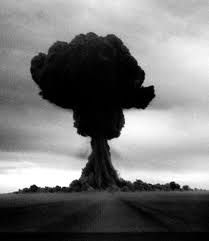Meditation
My Summer as a Peaks Freak
A revisited TV series features questions about the evils of nuclear war
Posted July 26, 2017

I never expected my decision this summer to revisit Twin Peaks, David Lynch and Mark Frost’s, much touted return of their two -season TV series from 1990-`91, to prove so thought-provoking. Nearly half-way through the new series’ promised 18 hour-long episodes came Episode 8. It shot right up there into the cinematic stratosphere, at least the equal of scenes in 2001:A Space Odyssey, Melancholia, Tree of Life and other cinematic treatises on the birth, and/ or, the death, of our universe. Filmmaker Lynch was offering a meditation on the origins of evil in our country, tracing it back to our use and abuse of the atom bomb.
When I first heard about Twin Peaks, I knew nothing about David Lynch. I remembered his depiction of the freakishly deformed but artistically gifted Elephant Man – Lynch’s first cinematic success. But I found Blue Velvet eerie and confusing, and I don’t think I’ve seen Mullholland Drive, his purportedly creepy Eraserhead or his other works.
My partner and I watched the start of the original Twin Peaks, however. And we were riveted- at least at first.
The drama centered on the murder of a beautiful blond high school beauty queen in the small, fictional north - west town of Twin Peaks.
Lots of TV programs feature unsolved murders. But this series was different. Answers remained elusive. Despite its disjointed narrative, the drama felt more like real life.
Anyone who’s covered an actual murder trial knows that in a real courtroom, a crime’s motive and solution seldom, if ever, provide the whole truth, the sought-for closure. Instead, a real murder often rips open the seemingly placid surface of `ordinary’ life. At times, the victim’s family turns out to be as dysfunctional as that of his or her murderer. And a murder’s ramifications can expose unsavory, hidden realities – like the jaded life of the fast-track teen friends of murder victim Jennifer Levin and her `Preppy Murder' killer Robert Chambers, a trial I covered a few years before Twin Peaks debuted on the air.
But Lynch’s unfolding story was more than just about the ugly, or evil, life beneath the seemingly tranquil, perfect life in suburban Twin Peaks.
Lynch’s drama was unique in other ways. It combined startling horror coupled with folksy humor, in addition to a large cast of quirky, unforgettable characters, whose behavior often veered into the surreal. These included a lady who walked about getting messages from a log she carried with her and an evil spirit named BOB, who could enter human hosts and cause them to commit murder or other horrific crimes. Starring was actor Kyle McLachlan. as brilliant but genial FBI investigator, Dale Cooper, a man who’s addicted to `A damn good cup of coffee’ and cherry pie, but who at times finds clues to beauty queen Laura Palmer’s murder in his dreams.
However the series grew ever weirder and more bizarre. It became laced with mysticism, symbols, portals to a supernatural netherworld, The Black Lodge, located behind swirling red velvet drapes. Housed inside the Black Lodge were a dancing dwarf, a talking arm, and evil `doppelgangers’–some inhabited by BOB - of Twin Peak’s residents, from the murdered Laura Palmer, to Twin Peaks hero – and newly BOB - possessed Agent Dale Cooper.
My partner and I soon lost patience trying to fathom all these other-worldly goings on.
But this summer, on reading that David Lynch and his co-creator, Mark Frost, planned to revisit their story on Showtime a quarter century after its Season Two’s demise, I immediately began to binge-watch.
I watched enough of the original series to get my bearings. This time, thanks to Google, I also read on-line reviews of the show, and I even skimmed several books about Lynch and the series. I realized how little I’d understood of the show’s themes, chiefly its focus on the push and pull between good and evil forces, and the violence of men against women. For the first time I also began to grasp the significance of BOB – the inverse of GOD? - whose capacity to wreak evil seems almost unstoppable.
I learned too that Lynch is a devotee of Transcendental Meditation; he practices and speaks widely about it. The result of his purported plumbing of, or into, what he calls pure consciousness is reflected in the surrealism- the astonishing creativity- that colors his free-ranging, startling juxtapositions - his strange, stream of consciousness-seeming narration.
Twin Peaks: The Return, like the original series, also features a murder- this time a murder that appears to have been actually committed in another dimension; a man’s finger prints are all over the murder victim’s body and room, but the accused murderer insists that he’s innocent, that the murder only happened in his dream.
To date, The Return has again presented a surreal mix of gruesome cruelty juxtaposed with genial humor. But the new series seems even more focused on BOB. And the plot threatens to climax in a battle between an evil Agent Cooper, and a good Agent Cooper, who’s trying to get his bearings outside of The Black Lodge.
But weeks before came Lynch’s Episode 8.
The hour had barely begun when the screen went black, and words on the screen took us to the count-down to 1945’s first atom bomb test site on the New Mexican desert.
As the shrill, discordant music, Threnody to the Victims of Hiroshima- (a song of sorrow) -, screamed in the background, the camera zeroed into the heart of the familiar image of the growing black mushroom cloud.

Next black and white explosions fell scattershot across the screen, followed by angry bursts of orange, yellow and purple. Above the swirls of color, then of raging black and white clouds, drifted a strange white figure that belched eggs across the screen. In an orb above an egg, the face of BOB floated in the sky.
Blotches of purple, orange, greens continued to churn across the screen, mixed with billowing clouds of fire.
Like other viewers, I was reminded of the end of Stanley Kubrik’s 2001, when the astronaut hurtles towards Jupiter, to be reborn a star child.
But Lynch and Frost were showing a different kind of birth (or death): how our twin bombings of Hiroshima and Nagasaki, coupled with technology, gave birth to BOB and other unspeakable, perhaps unstoppable, corruptions of our life today.
I sat shaken, long after this episode had ended.
I’d never had much patience with my own crystal-gazing, meditating friends.
But watching this program, I felt that David Lynch had reached into my own consciousness.
Less than two weeks before Episode 8's screening, a friend and I had been amazed to find that we agreed that President Harry S. Truman had committed a moral atrocity in dropping the two atom bombs on Japan – at a time when many people, including top members of government and the military believed that Japan’s readiness to surrender made the bombings unnecessary. Now, in what one TV critic termed `an astounding visual poem on the genesis of evil,’ Lynch had made clear his own belief, much harsher than mine, that dropping those weapons had loosed new, almost uncontrollable evil into the world.
Episode 8 returned to earth with a few more Lynchian horrors.
I’ve no idea where it’s all heading, but I was on edge throughout. I felt I was connecting with a work of genius.
In contrast to my reaction back in the nineties, Lynch and Frost’s Twin Peaks: The Return has turned me into a true Peaks freak.




